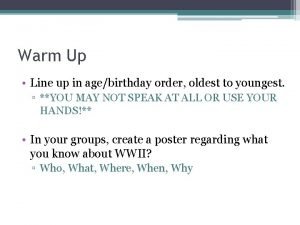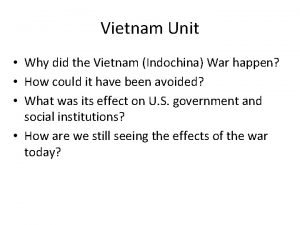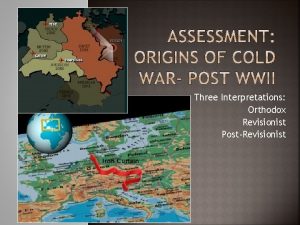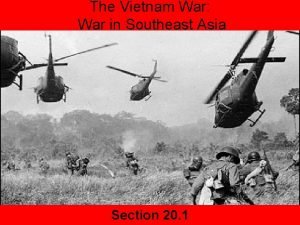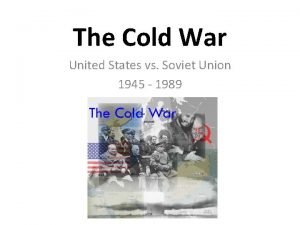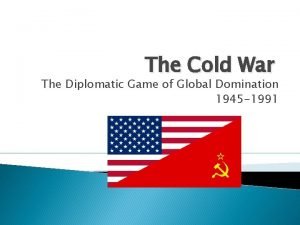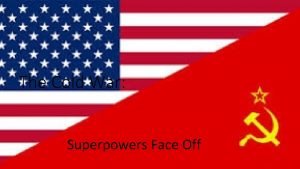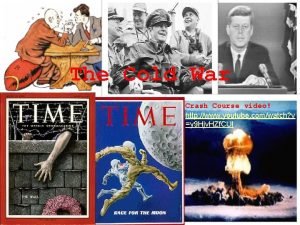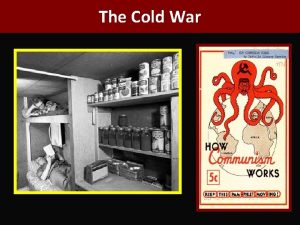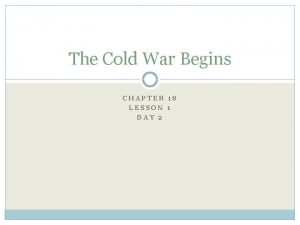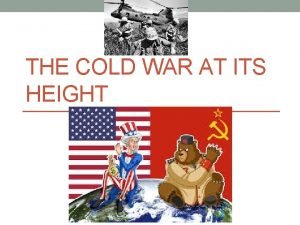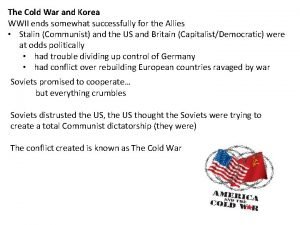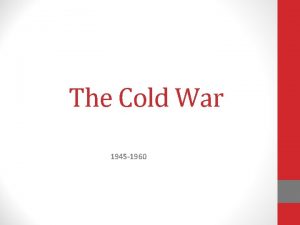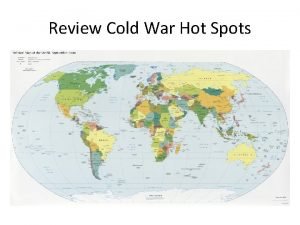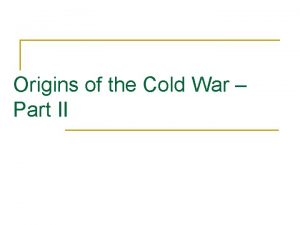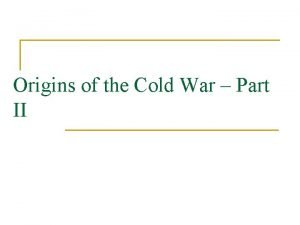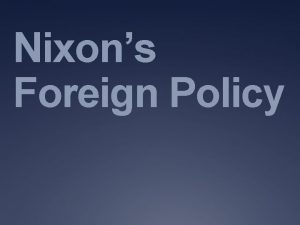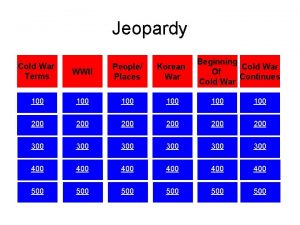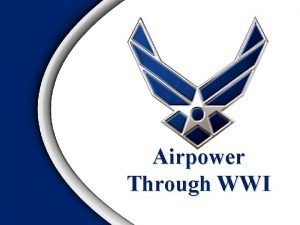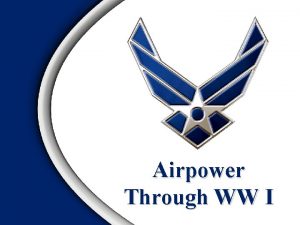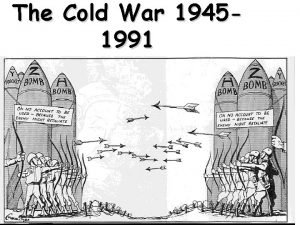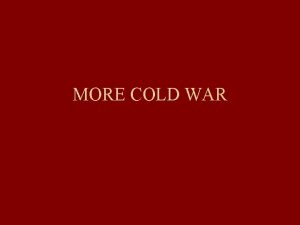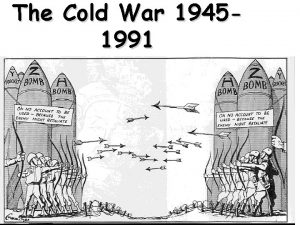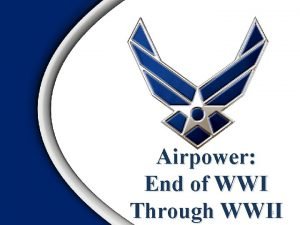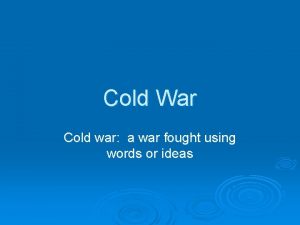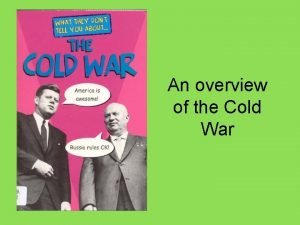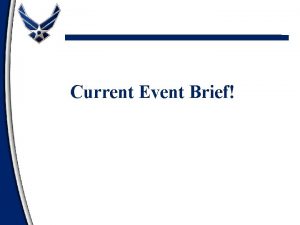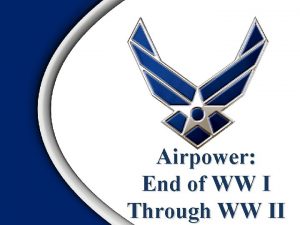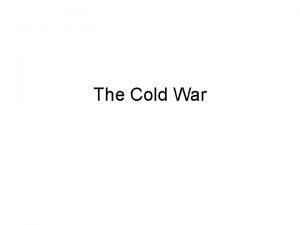Airpower Through the Cold War 1 Overview National



























- Slides: 27

Airpower Through the Cold War 1

Overview • • • National Security Act of 1947 Berlin Airlift Curtis Le. May Korean Conflict Cuban Missile Crisis 2

National Security Act of 1947 • Established the framework for the future Department of Defense and created the Air Force • Executive Order 9877 outlined the main functions of the Air Force • The United States Air Force stood up on 18 September 1947 3

Circumstances after WWII • Soviets intent on security of their borders – Russia had been invaded twice • Soviets suffered millions of casualties in the WWII invasion • Allies were not seeking vengeance in Germany • Allies wanted to revitalize and stabilize economy 4

Allied Occupation Zones • • Soviets given East Germany to include Berlin United States given southwest Germany Britain given northwest Germany Berlin then divided, and Allies, including France, each given a sector inside Berlin itself 5

Blockade • Soviets refused to supply food • Soviets allowed three air corridors • Soviets demanded their currency (money) be adopted • Soviets blockaded road, rail, and waterways • Soviets cut off all power 6

Allied Response (United States) • Airlift mission begins • Backup of airlift through basing of strategic nuclear capability in England (36 B-29 s deployed) 7

Airlift Begins • • 25 June 1948 C-47 (Skytrain) could fly 2 to 3 tons of cargo C-54 (Skymaster) could fly 10 tons of cargo 2 million tons of cargo in almost 277, 000 flights C-54 C-47 8

Tunner Video 2 9

Results • Diplomatic weapon • Technological achievement • Strength of airpower 10

General Curtis Le. May “I don’t mind being called tough, since I find in this racket it’s the tough guys who lead the survivors. ” ~ Colonel Curtis E. Le. May, to Lt Gen Ira Eaker England, 1943 11

Le. May Video 2 12

General Curtis Le. May • Navigator on B-17 as lieutenant in early airpower demonstration with ocean liner “Rex” in 1938 • Commanded units in Berlin airlift • Commander in Chief, Strategic Air Command (CINCSAC) • Air Force Chief of Staff 13

Le. May’s Impact on the Air Force • • • More realistic training programs Bottom line—discipline Procured personnel and aircraft Bombers became airborne nuclear alert Nuclear deterrence became a reality 14

Korea Intro Video 15

Korean Conflict • National Security Council (NSC) directive 68 called for a massive increase in defense spending to contain Communism (April 1950) • Korea was the first test of American resolve Korean War Service Medal 16

Beginning of Korean Conflict • June 25, 1950, North Korea launched a surprise invasion of South Korea • Congress approved use of force to repel North Korean invasion (no formal declaration of war) • UN Security Council authorized aid (Gen Douglas Mac. Arthur named Commander) 17

Tunner Video 3 18

Korean Conflict • UN forces were saved at the Pusan perimeter by around the clock bombing and interdiction • Mc. Arthur launched surprise amphibious assault at Inchon • UN forces drove North Koreans back across 38 th parallel and attempted to unify the country • China entered, pushing the UN forces back 19

Airpower in Korea Video 20

Airpower in Korean Conflict • First use of jet fighters on both sides – Mi. G-15 outperformed F-80 – Mi. G-15 retreated back to bases in China – Airspace south of Yalu river known as “Mi. G Alley” – F-86 Sabre proved superior to the Mi. G-15—Kill ratio of 10 to-1 MIG-15 F-80 F-86 21

Airpower in Korean Conflict • Contributions of airpower to the Korean conflict – Counterland: Airpower operations conducted to attain and maintain a desired degree of superiority over surface operations by the destruction or neutralization of enemy surface forces • Interdiction: Operations to divert, disrupt, delay, or destroy the enemy’s surface military potential before it could be used effectively against friendly forces • Close Air Support: Operations against hostile targets in proximity to friendly forces 22

Schriever Video 23

Deterrence and Missile Development • SNARK • Atlas, Titan • Minuteman became the mainstay of SAC’s missile retaliatory force • NORAD established in 1957 • Single Integrated Operational Plan for using nuclear weapons (SIOP) 24

Cuban Missile Crisis • Sept 1962—U-2 reconnaissance plane detailed Soviet missile launchers in Cuba • US missile force placed on alert status • President Kennedy chose option of naval quarantine • Soviet Union backed down and the nuclear crisis was averted • Doctrine of “Flexible Response” evolves 25

Key People Gen Tunner Gen Partridge Gen Le. May Maj Herser Key Events Berlin Airlift Korean War “New Look” Cuban Missile defense strategy Crisis Key Weapons C-47, C-54 B-26, B-29, P-51, F 80, F-84, F-86 B-52, ICBMs U-2 Key Doctrinal Emphasis Strategic Airlift Tactical Airlift CAS, Interdiction Strategic Attack Reconnaissance

Summary • National Security Act of 1947 • Berlin Airlift • Gen Curtis Lemay • Korean Conflict • Cuban Missile Crisis 27
 Welcome 1 unit 10 lesson 1
Welcome 1 unit 10 lesson 1 Proxy war cold war definition
Proxy war cold war definition Health tb
Health tb Acrostic poem
Acrostic poem Operation rolling thunder cold war
Operation rolling thunder cold war Postrevisionist
Postrevisionist Iron curtain political cartoon answers
Iron curtain political cartoon answers Operation rolling thunder cold war
Operation rolling thunder cold war Cause of the cold war
Cause of the cold war The cold war thaws worksheet answers
The cold war thaws worksheet answers U2
U2 Cold war superpowers
Cold war superpowers Cold war crash course
Cold war crash course Characteristics of cold war
Characteristics of cold war Starkweather homicide 1958
Starkweather homicide 1958 Lesson 1 the cold war begins
Lesson 1 the cold war begins The cold war at its height
The cold war at its height Cold war who was involved
Cold war who was involved Non aligned countries during cold war
Non aligned countries during cold war Two sides of cold war
Two sides of cold war Effects of cold war
Effects of cold war Cold war pictoword
Cold war pictoword Cold war hot spots
Cold war hot spots Origins of the cold war
Origins of the cold war Origins of the cold war
Origins of the cold war Vietnamization definition
Vietnamization definition Why did stalin want to create a “buffer zone”?
Why did stalin want to create a “buffer zone”? Agent orange and napalm
Agent orange and napalm



